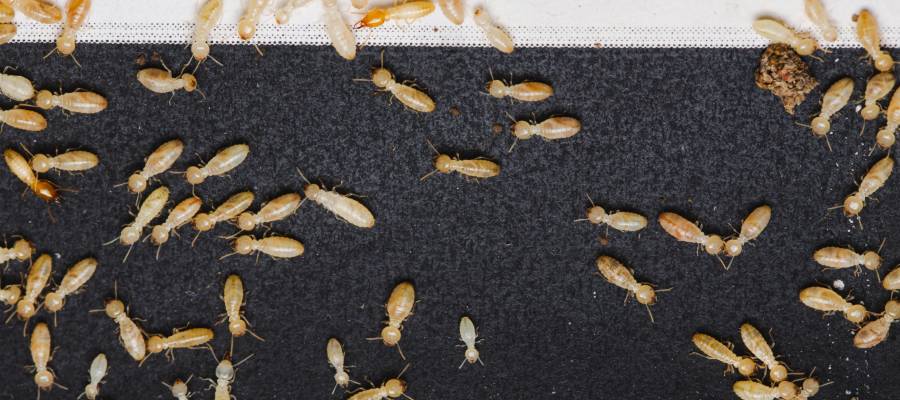
Have you been noticing tiny white bugs inside your home, but you can’t quite figure out what they are? They are likely termites, whiteflies, springtails, clothes moths, grain mites, or booklice.
Proper pest identification helps you understand your risks and what steps to take next. With some types of tiny white pests, it might be a matter of tolerance – how much are they bothering you, and can you ignore them? However, some types of tiny white pests can be dangerous, and you should eliminate them as soon as possible.
So, what are those tiny white bugs in your house? Let’s talk about the most likely culprits.
Which tiny white bugs do I have?
One person’s idea of “tiny” can differ from another’s. Also, your “white” might seem like “off-white” to someone else. That “tiny white pest” could be describing any number of pests, but it’s a start at least.

When someone calls us about “tiny white insects,” most of the time, they end up being one of these:
Termites
Termites may be small, but they’re not exactly tiny compared to many kinds of pests. Many people call them “tiny white pests.” This is because subterranean termite workers and some soldiers are milky-white and less than 1 cm long. You can identify them by their bulbous abdomen and red-orange pincers.
If you spot them in your home, call termite control right away. Termites are the most destructive pests, causing over $5 billion worth of damage annually.
Whiteflies
If you find a tiny fly that’s white and you’re not sure what it is, its name might be right under your nose. Whiteflies look like aphids and mealybugs.
They are common garden pests. However, they can also invade our homes through houseplants and produce. They truly are “tiny white pests,” but they’re not nearly as common in homes as termites.
Springtails
Tiny white to light gray insects that can appear in bathrooms, basements, or other damp areas. They’re harmless but can be present in large numbers.
Clothes Moths
Clothes moths aren’t as common as they once were, but they can wreak havoc on your closet. In the past, you’d find mothballs in almost every closet. These days, thanks to better construction and sealing, infestations are much less common.
With clothes moths, it’s actually the larvae that you want to look out for. These “tiny white pests” look like small worms and will eat practically any clothing and fabric they find.
Grain Mites
If you see “tiny white pests” in your kitchen or pantry, they might be grain mites or another pantry pest. These minuscule white pests feed on processed grains, cheese, flour, and cereals. They often leave behind a brown tinge called “mite dust” on food products that they infest.
They’re truly tiny and can be easy to miss if you’re not looking carefully.
Booklice (Psocids)
Small, pale insects that feed on mold and are often found in damp books, papers, or food products.
All of these pests can have a negative effect on your daily goings-on to varying degrees. If you’re still unsure of what pest you’re dealing with, talk to an exterminator near you.
What should you do if you find tiny white pests in your home?

The key is identifying them first. Once you have identified the tiny white pests in your home, you’ll know what to do next.
- For termites: Act quickly. Early intervention stops serious long-term harm to your home’s structure. Professional help is essential.
- For whiteflies: Take out affected houseplants or use insecticidal soap to treat them. Check new plants before bringing them inside.
- For clothes moths: Clean the clothes that are affected. Vacuum well. Also, think about using cedar blocks or other repellents in your closets.
- For grain mites: Dispose of infested food products, clean pantry shelves thoroughly, and store dry goods in airtight containers.
- For springtails: Reduce moisture in affected areas. Fix leaky pipes and use dehumidifiers in damp spaces like bathrooms and basements.
- For booklice: Lower humidity levels, remove moldy materials, and discard heavily infested books or papers.
The one thing you don’t want to do when you discover tiny white pests in your home is ignore the situation. With any type of infestation, as it grows, the infestation becomes bigger, and so do the potential problems. Even pests that seem harmless can point to issues, like excess moisture, that need attention.
Should you call an exterminator?
If it’s termites, yes, call right away. Termite damage builds up quickly. So, it’s important to get a professional to remove colonies and protect your home. For pests like whiteflies, clothes moths, grain mites, springtails, or booklice, getting professional help can save you time and stress after trying DIY methods.
And if you’re not sure what type of pest it is, call and get an inspection so you can know for sure. Pest control experts, like us at Bug Out, know how to spot tiny white pests. We have the training and experience to find them before suggesting the best treatment plan.
Tiny White Bug Control in Lubbock TX
If you have tiny white bugs at home, like termites or grain mites, call your local pest control expert, Bug Out. We can help you get rid of them safely. Our team keeps up with the latest pest control innovations, focusing on efficiency and being environmentally responsible.
Call us today with any questions or if you’re ready to schedule service!
Back to "Fly Pest Control & Exterminator Services in Lubbock TX"